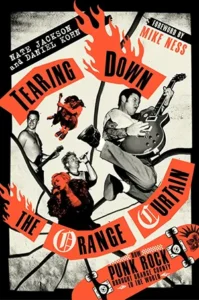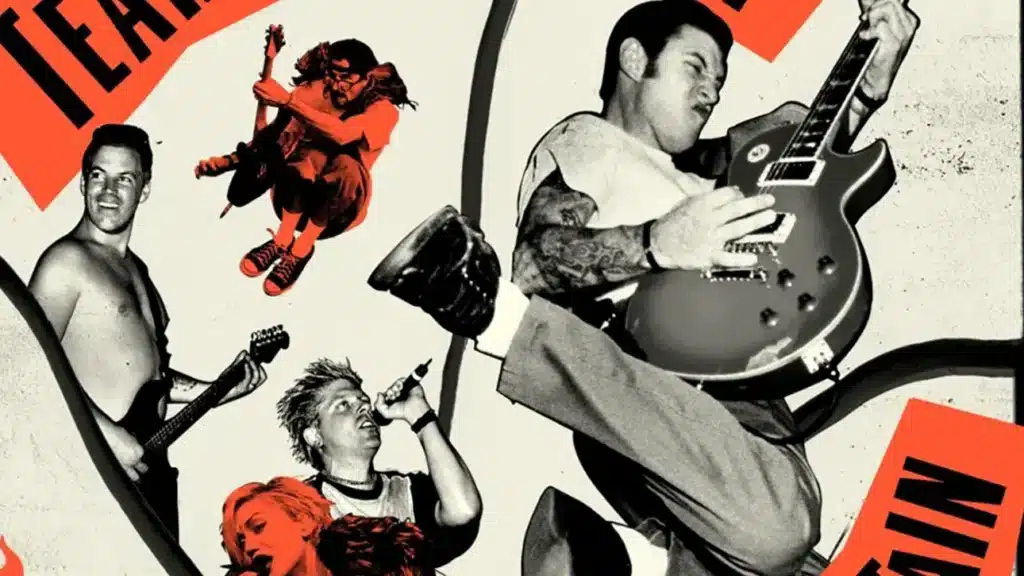
SoCal punk music history book Tearing Down the Orange Curtain has gobs of literary equivalents to falling off the stage.
 Tearing Down the Orange Curtain: How Punk Rock Brought Orange County to the World Nate Jackson and Daniel Kohn Da Capo May 2025
Tearing Down the Orange Curtain: How Punk Rock Brought Orange County to the World Nate Jackson and Daniel Kohn Da Capo May 2025
Punk music generally prioritizes authenticity over technical proficiency and polished execution. The genre was created by young people disillusioned with the self-congratulatory flower power of the 1960s and bored with the rock excess of the early 1970s. A key element of punk is an openness to raw performance that inherently includes what fans might call freedom of expression, but critics label as mistakes. Tearing Down the Orange Curtain presents this dilemma.
Consider: In Legs McNeil and Gillian McCain‘s seminal book from 1996, Please Kill Me: The Uncensored Oral History of Punk, the New York Dolls vocalist David Johansen claims, “People who saw the Dolls said, ‘Hell anybody can do this.’ I think what the Dolls did as far as being an influence on punk was that we showed that anybody could do it” and Dee Dee Ramone remembers a poor audition when “I was kicked outta there because I couldn’t play good.”

In 2007’s My So-Called Punk: Green Day, Fall Out Boy, the Distillers, Bad Religion—How Neo-Punk Stage-Dived Into the Mainstream, Bad Religion’s Brett Gurewitz tells journalist Matt Diehl that, “You don’t have to be a virtuoso, you don’t have to know music theory… All you have to do is have a lot of heart and put yourself out there. It’s inclusive.”
However, there is a scale to the Passion vs. Polish equation. A wrong note in a dive bar live performance is one thing, an untuned guitar on a major label studio release is another. A typo in Mark Perry’s xeroxed zine Sniffin’ Glue differs from a misstep by Greil Marcus in Rolling Stone. Which makes it difficult to evaluate Nate Jackson and Daniel Kohn’s Tearing Down the Orange Curtain: How Punk Rock Brought Orange County to the World.
The book, written by two seasoned journalists, examines the unique SoCal (Southern California) influence on punk music. It features a foreword from Social Distortion’s Mike Ness, the only non-Polynesian man alive who looks cool with a face tattoo, and a blurb from Guns ‘N Roses Duff McKagan, who I wish I could be when I grow up. It’s edited by a pioneering pro I have long admired. It creates a compelling atmosphere of punks brawling in parking lots and expertly pilots the complicated band histories. There is a lot to like about Tearing Down the Orange Curtain.
But there are gobs (pun intended) of literary equivalents to falling off the stage. Enough to wash away the stage at London’s historic 100 Club.
Frequently, Jackson and Kohn could benefit from simply reading their work aloud. For a book about a rapid-fire musical genre with short songs, some sentences read more like failed prog rock odysseys. Read the following passages slowly and go ahead and sound them out verbally if you need a warmup for debate class.
- “In the midst of the wild underground backyard party scene sparking in the mid- to late ‘70s, a middle-aged man living in Laguna Beach who decided to set up a punk club in the middle of Orange County for a bunch of kids could’ve never understood at the time that the shows within its walls sowed the seeds of a groundbreaking subculture that would still be talked about to this day.”
- “When Guerinot saw Ness dipping into the bathroom, he knocked on the door and went in when he shot up. He saw how much Ness was using, and warned him that he was using too much.”
- “Torvar, who was twenty years old when he started promoting shows, learned about punk through the heavy-handed crackdown he’d witnessed at punk shows around SoCal via his younger sister Bianca, who was going to local punk shows at the time.”
- “That quick appearance on KDOC was just about the only press they got for the record—not quite enough to land a real manager, even the guy who later became their manager, Jim Guerinot, who at the time was with A&M Records in addition to managing Social Distortion.”
Indeed, there are instances in Tearing Down the Orange Curtain where it seems the writers try to make a point of a contrast that isn’t actually a contrast or surprising. The punchline simply doesn’t land.
- “Danell wasn’t one of the rich kids, but he had the desire and determination to succeed.”
Punk musicians balance appearing too cool or nihilistic to care about commercial success with an intense pride of DIY work ethic. This apparent contradiction might contribute to the confusion of this sentence. So, are the writers implying that the rest of the musicians from broken homes didn’t have desire and determination?
- “That left only three solid local options for the Offspring—the VFW Halls, local bowling alleys, and the ever-so-cool community rooms run by the Knights of Columbus. (Los Angeles’s Anti Club was an option as well.)”
Doesn’t that make it four options?
- “At some point in the middle of it, the road-weary band must have thought about trading its kingdom—or at least its battered Dodge Ram touring van—for a Lear jet.”
The Shakespearean twist of phrase implies that circumstances are so dire, one exchanges a lot for a little. The Cadillac Tramps band members trading a piece of shit van for a baller private jet is the opposite of the phrase’s convention. It’s a bit like saying that you would trade a rancid leftover burrito for the $350 tasting menu at Le Bernadin.
T.S.O.L.’s vocalist Jack Grisham writes in his memoir that “God, I hate that cliché.” Yet in Tearing Down the Orange Curtain, Jackson and Korn don’t mind churning them out in their description of area musicians. There are colleagues “who got on each other’s nerves and didn’t see eye to eye…” and another dude with “the experience of cutting his teeth…” and someone who “became known for telling it like it was within the OC punk scene…”
All of which makes it challenging to truly love the book. It’s not exactly “full of spit and vinegar, but it’s also really fun.”
One might argue that these are the quibbles of a scold. Just insignificant linguistic frivolities. Like punk music itself, “mistakes” in the text should be overlooked because of the heart. That the true merit of Tearing Down the Orange Curtain is in its substance and exhaustive look at the material. That would not be wholly misguided.
Where Tearing Down the Orange Curtain Hits the Right Note
A third of the book is a detailed account of Mike Ness and Social Distortion’s life and career. This throughline is a useful anchor. Just when obscure bands that all start with “the” pile up in your head, Jackson and Kohn return to the familiar touchstone of 1983’s Mommy’s Little Monster. Social Distortion is well-known enough to be a stable foundation for Tearing Down the Orange Curtain, but sufficiently undocumented to be interesting to the mainstream audience.
Many of those passages are well-executed, such as when a newly sober Ness declines painkillers after a motorcycle crash. The ER docs pull out a wire brush, and the man described as “having a chest-cold sneer of a voice” toughed it out. It’s a great metaphor for someone whose survival and evolution are depicted throughout the book.
Other Orange County (O.C.) bands, such as the Offspring and No Doubt, had more commercial success. None lived it longer than Social Distortion. Given the glut of rock memoirs from everyone with a Marshall amp stack, Mike Ness is one of the holdouts, the last to officially share his story. Until he does, Tearing Down the Orange Curtain is a good overview of his life.
With Social Distortion as the headliner, Sublime, No Doubt, and the Offspring occupy prime slots just one notch lower on the bill. Unsurprisingly, the Offspring’s Dexter Holland, who earned a PhD in molecular biology, steals the show in Tearing Down the Orange Curtain with his humor and insight.
Another positive is the spotlighting of bands that you might only know in passing. Previously, my knowledge of T.S.O.L. was Steven Adler’s T-shirt in the “Sweet Child O’ Mine” video. I learned of Manic Hispanic from tattoo legend Freddy Negrete’s social media feed. Drummer to the stars Josh Freese recently crossed a new level of fame because of his Foo Fighters experience. These performers, and many more, are richly explored in Tearing Down the Orange Curtain, and I’ve added half a dozen records to my collection thanks to this work.
As you learn about bands such as Adolescents, the Mechanics, the Descendents, and the Slashers and venues like the Cuckoo’s Nest and the Doll Hut, the geography of Southern California becomes incredibly important. The variations of styles and personalities from neighborhood to neighborhood is vividly explained.
Sublime was here, No Doubt came from over there, the Vandals were from that place, Agent Orange from this other neighborhood. “When you lay it out on a map of the city connecting the dots between cross streets and clustered points of punk interest, it all makes sense,” Jackson and Korn write. It would have been cool if the book had a map, a Middle-earth-style cartography of punk. The county limits mark a total of 948 square miles, but in Tearing Down the Orange Curtain, it feels simultaneously claustrophobic and vast as the bands merge, mingle, and migrate.
Indeed, the sense of place is acute and lives up to the book’s billing. Ultimately, I am glad that I read Tearing Down the Orange Curtain for what I learned, but it’s a struggle to overlook the execution.
Caroline Coon covered the early punk era in London for Melody Maker and other outlets. “I was fascinated by the dilemma of an artist who has an idea and not yet quite the technique with which to express the idea,” she says in Jon Savage’s England’s Dreaming: The Sex Pistols and Punk Rock (1991). “To see them struggling with their technique to get the songs across was superb: that got a white-hot fire going onstage.”
Jackson and Kohn have the technique; their other publications prove it. They’re pros. Perhaps Tearing Down the Orange Curtain just needed more time in the studio, some more takes. Instead of white-hot set your hair on fire read, it’s just comfortably warm.


